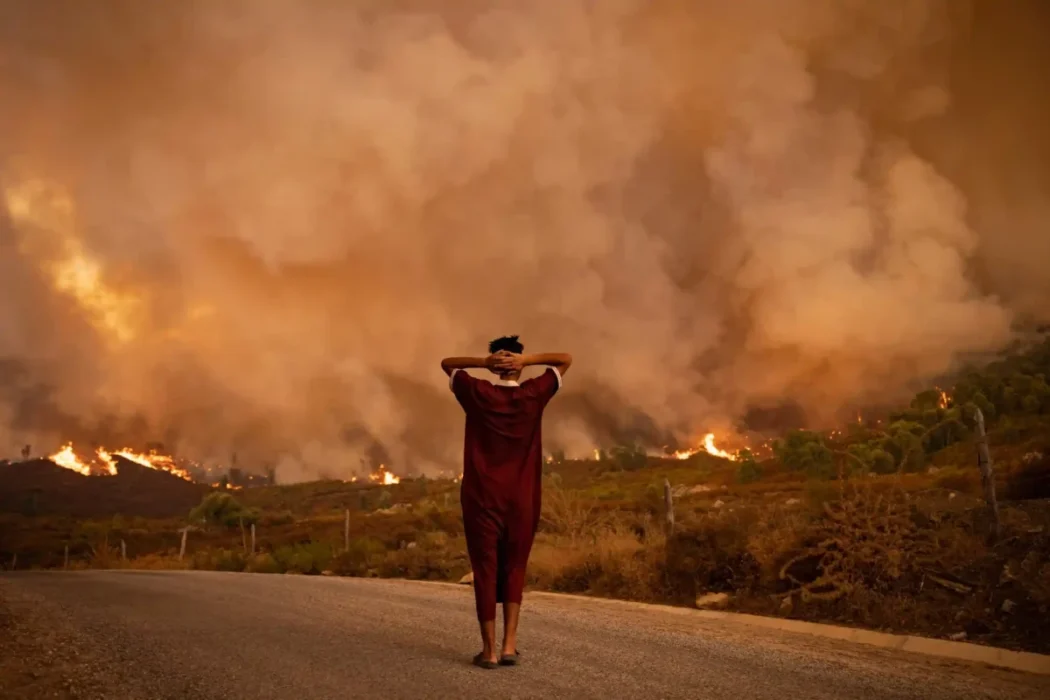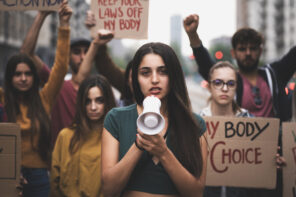The Cop26 summit in Glasgow begins on Monday: our environment correspondent traces the long buildup – and the implications of failure
by Fiona Harvey
[dropcap letter=”I”]In the Marshall Islands people are used to the vagaries of the ocean. But recently the monthly “king tide” has brought new perils to this small group of islands in the Pacific about halfway between Australia and Hawaii. Waves crash over the roads and airport runways, especially when the unusually high tide coincides with a storm surge, cutting off communication and making daily business dangerous or impossible.
The islanders’ lives are now full of inescapable reminders of climate breakdown, says Tina Stege, the climate envoy for the tiny nation of 60,000 people on 29 atolls. “We see stronger storms and storm surges. Droughts are more frequent and more intense and longer. Growing up I remember just one very intense drought; now they’re happening maybe every three years. We recently had a dengue fever emergency, a problem we’re seeing now in the winter months as they get warmer.”
Stege is chair of the High Ambition Coalition, a grouping at the UN climate talks that brings together some of the world’s richest nations, including the EU, and some of the poorest and most vulnerable, to push for stronger climate action. Small island developing states are feeling the impact of climate change, but so, too, are far more populous countries, from low-lying Bangladesh to landlocked Rwanda, also members of the HAC, which represents more than 1 billion people around the world.
We are a small nation, but we have moral authority – our position on the frontline gives us that,” says Stege. “We need to raise our voice, as these changes will affect the whole world in time.”
These vulnerable countries are preparing for what many see as the last chance to save their people from devastating climate catastrophe. The Cop26 climate summit will gather more than 120 heads of state and government and representatives of nearly 200 countries to forge a plan aimed at holding global heating to 1.5C above pre-industrial levels.
Small developing countries, and their moral authority, are a large part of the reason delegates are meeting with that goal of “keeping 1.5C alive”, as it is framed by the UK hosts. It means all countries must come forward with national plans to reduce greenhouse gas emissions, preserve forests and other carbon sinks, and move to a green economy.
Cop26 is the biggest diplomatic event on UK soil since the second world war, and is a crunch moment for attempts to tackle the climate crisis, because scientists say there is just a decade left in which to take crucial action to prevent more than 1.5C of warming. Alok Sharma, the UK cabinet minister who is president of the talks, told the Guardian failure at Cop26 would be “catastrophic”, adding: “I don’t know another word for it. You’re seeing on a daily basis what is happening across the world. Last year was the hottest on record, the last decade the hottest decade on record.”
The 1.5C limit is the core aim of the talks; the Paris agreement of 2015 required nations to hold global temperature rises “well below” 2C, and to “pursue efforts” to limit rises to 1.5C. That lower temperature limit was included in the agreement at the vocal insistence of the HAC, just a few days before the Paris summit concluded. If they had failed, the world would almost certainly already be on an irreversible path to 2C of heating – a level that we now know, thanks to science completed after the Paris agreement was signed, would lead to far worse impacts, including widespread drought, water shortages for billions of people, heatwaves and sea level rises. At 2C, small islands and low-lying coastal areas around the world would face inundation.
The question now is: can a pathway to 1.5C be kept at the Glasgow talks?
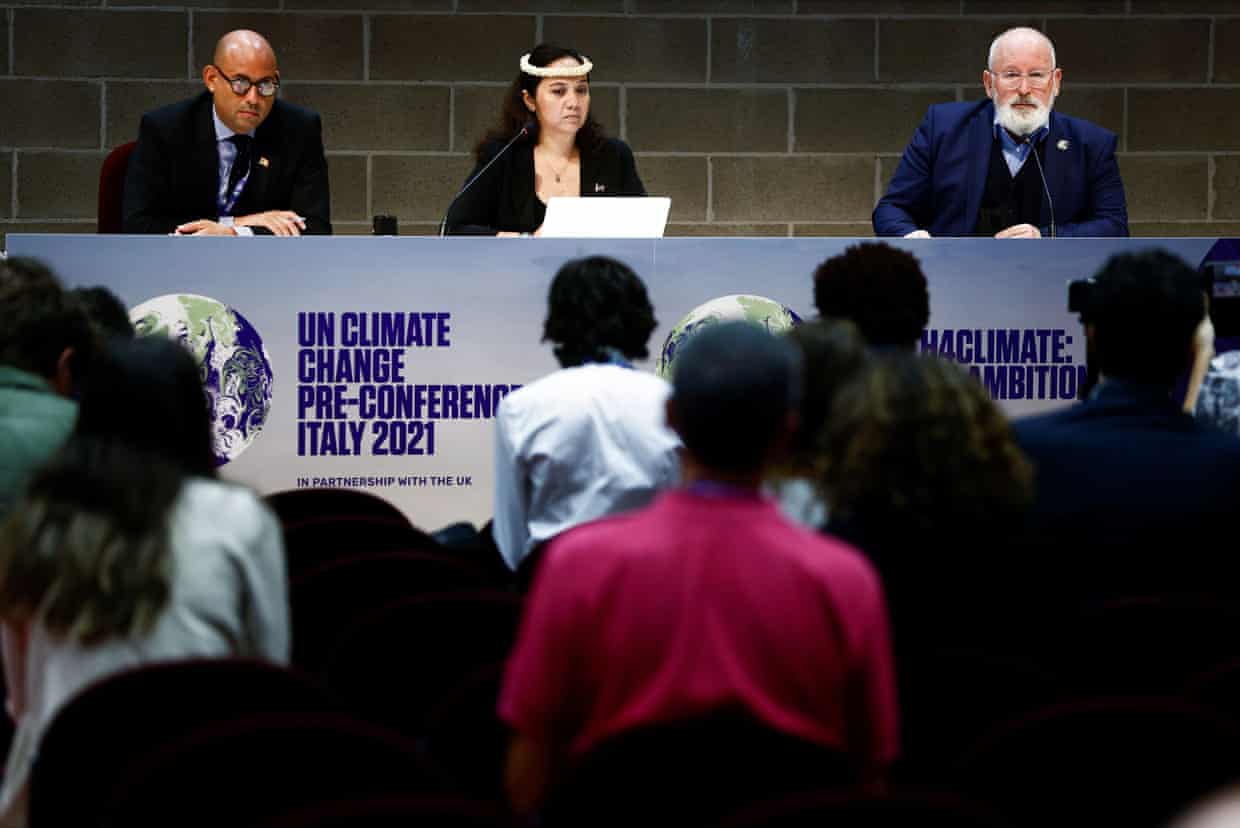
(From left) Grenada’s climate resilience minister Simon Stiell, the Marshall Islands climate envoy Tina Stege, and European Commission vice-president Frans Timmermans at Pre-Cop26 in Milan on 2 October 2021. Photograph: Guglielmo Mangiapane/Reuters
A conference of equals
Cop26 is the 26th conference of the parties to the UN Framework Convention on Climate Change, the treaty signed in 1992 that requires all of the countries of the world to take action on the climate crisis. There have been 25 Cops before now, and yet we still face a rapidly deepening catastrophe. Extreme weather has intensified, with heatwaves in Canada and Siberia, wildfires across the US and Australia, and devastating floods in Europe and China in the past year alone. Last year was the hottest on record, alongside 2019 and 2016.
At Cops, the majesty and the unwieldiness of the UNFCCC process are immediately apparent. This is one of the last remaining forums in which the governments of the world meet to debate global issues as equals. Most international conferences today are a stitch-up among major economic powers – the G7 group of the world’s biggest industrialised economies, the G20 group of the biggest economies including the still-developing ones – or have dwindled into ever-narrower special interests, like the Aukus defence pact. But the UNFCCC involves every nation, bar a few failed states, and gives each an equal say. Decisions can be taken only by consensus, which means the poorest countries – which are also those most vulnerable to the impacts of climate catastrophe – have, in theory at least, as much influence as the biggest.
Sharma recognises this: “I will ensure that every voice is heard, that the smallest nations are sitting face to face with the world’s great powers, as equal parties to the process.”
Putting the 1.5C target into the Paris agreement “was based on hard work by the High Ambition Coalition and the small island developing states,” John Kerry, climate envoy to the US president, Joe Biden, told the Guardian.
They felt it that it was imperative – and thank heavens they did. Science has now caught up to that fact, the IPCC [Intergovernmental Panel on Climate Change] and IEA [International Energy Agency] and others have been pretty clear, that this is what we need to try to achieve.”
Aiming for a 1.5C limit makes this Cop more ambitious – and perhaps in even greater danger of failure – than the Paris summit of 2015. At Paris, 197 countries were wrangled by masterful diplomacy into an accord that legally binds the world to limit heating to “well below” 2C, while “pursuing efforts” to remain within 1.5C. It was the first time developed and developing countries had agreed a specific and binding temperature goal.
The distinction between 1.5C and 2C may seem small – unnoticeable, to most people, in everyday life. But for the planet, the difference is vast. During the last ice age, temperatures were only about 4-5C colder than they were today. Millions of years ago, at temperatures 4C higher than today, the poles were ice free and covered in swampy jungle. The world today is about 1.1-1.2C hotter than it was in pre-industrial times, and already the impacts of extreme weather are being felt.
In a landmark report published in August, which gave the starkest warning yet from scientists on the climate crisis, the IPCC – the global scientific authority on climate science – made it clear that every fraction of a degree counts. Every seemingly small rise in global temperatures presages much greater impacts in the climate system, and every extra bit of heat makes weather more extreme. “You are promoting moderate extreme weather events to the premier league of extreme events,” said Richard Allan, a professor of climate science at the University of Reading, and an IPCC lead author.
The IPCC findings show that the 1.5C threshold is not a cliff-edge to disaster, but the start of a steep slope. Its assessment found there was a narrow pathway remaining to hold warming to 1.5C, but even if we overshoot, we should be trying to avoid anything further – warming of 1.6C is still much safer than warming of 1.7C.
“At 1.5C, 700 million people would be at risk of extreme heatwaves. At 2C, it would be 2 billion. At 1.5C, 70% of the world’s coral reefs die. At 2C, they are all gone. If temperatures continue to rise, we will step through a series of one-way doors, the end destination of which is climate catastrophe.”
Kerry adds: “The reality is that scientists have now determined that we need to accelerate and need to do more – the levels of damage we are already seeing have been greater than anticipated and faster than anticipated. We have to take our cue from that, and respond.”
‘The starting line for the rest of the decade’
Cop26 is necessary because the 2015 Paris agreement set out the goals for tackling the climate crisis but did not contain sufficient commitments to achieve them. At Paris, countries came forward with national plans – called nationally determined contributions (NDCs) – to cut greenhouse gas emissions by varying amounts in the near-term, most of them pegged to a 2030 deadline. But these were too weak, and would lead to catastrophic warming of more than 3C if implemented.
For that reason, the French insisted on including a ratchet mechanism in the accord, forcing countries back to the negotiating table every five years to crank up their ambition on emissions cuts with fresh NDCs. Postponed for a year by Covid-19, Cop26 is that moment. Laurent Fabius, the French foreign minister who presided over Paris, said earlier this month: “This is the Cop of action, at which we apply the Paris agreement.”
Hopes that Cop26 would produce enough action to meet 1.5C have fallen short. The IPCC has made clear that emissions cuts of 45%, based on 2010 levels, are needed by 2030 for the world to stay within the 1.5C threshold. The major players – the US, the UK, the UN – have admitted, publicly and privately, that the cuts on offer in Glasgow will fall short of that emissions-cutting goal.
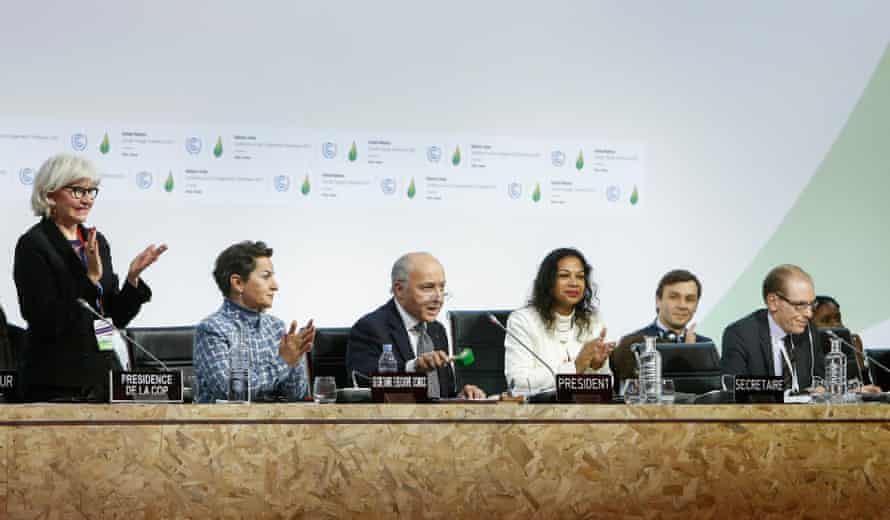
Then French foreign minister and Cop21 president Laurent Fabius (third from left) marks the adoption of the Paris agreement on 12 December 2015. Photograph: Zhou Lei/Xinhua/Alamy
However, they hope for a deal that will show that all the major developed and developing countries are taking strong action on greenhouse gas emissions, are formulating clear plans with concrete measures and policies to do so, and that pathways can be set out on key issues such as methane reduction, protecting forests and other carbon sinks, and phasing out coal.
“Will it be that every country has signed on and locked in [with NDCs adequate to 1.5C]? The answer is no, that will not happen,” says Kerry. “Glasgow has to show strong commitment to keeping 1.5C in reach, but that does not mean every country will get there. We acknowledge that there will be a gap [between the emissions cuts countries offer and those needed for a 1.5C limit]. The question is, will we have created a critical mass?”
Nor is Cop26 the end of efforts to stay within 1.5C. Rather, we should see the 2020s as a “decade of action”, in which the world finally brings emissions under control: “There is not a wall that comes down after Glasgow. It is the starting line for the rest of the decade,” says Kerry.
Unlike the Paris summit, which produced a binding global treaty, the outcome of the fortnight of negotiations in Glasgow is unlikely to be clear cut, adds Nicholas Stern, a climate economist and chair of the Grantham Research Institute on Climate Change at the London School of Economics. “We should hope for good progress, and for mechanisms and ways forward on how we close that gap [between emission cuts offered and those needed] further between now and 2025. We should look at the total emissions targeted for 2030. But a language of success or failure doesn’t seem to be me to be very helpful – to have a tick box doesn’t really make a lot of sense.”
Lord Stern lists five areas in which Cop26 needs to show progress: NDCs; climate finance; phasing out coal; nature-based solutions to climate change, such as preserving forests, peatlands and wetlands, and other carbon sinks; and the goal of net zero emissions by mid-century.
Nevertheless, if Cop26 does not produce a convincing roadmap for how the world can stay within 1.5C, it is hard to imagine how that limit will remain feasible. In 1992, when the UNFCCC was signed, it would have been possible to bring emissions down gradually over the course of a century, and still stay within the 1.5C threshold (though at that time it was not clear that 1.5C was a threshold). Now, because the climate responds to cumulative emissions, and carbon dioxide lingers in the atmosphere for about a century after emitted, every tonne emitted adds to the heating effect. We have almost run out of road.
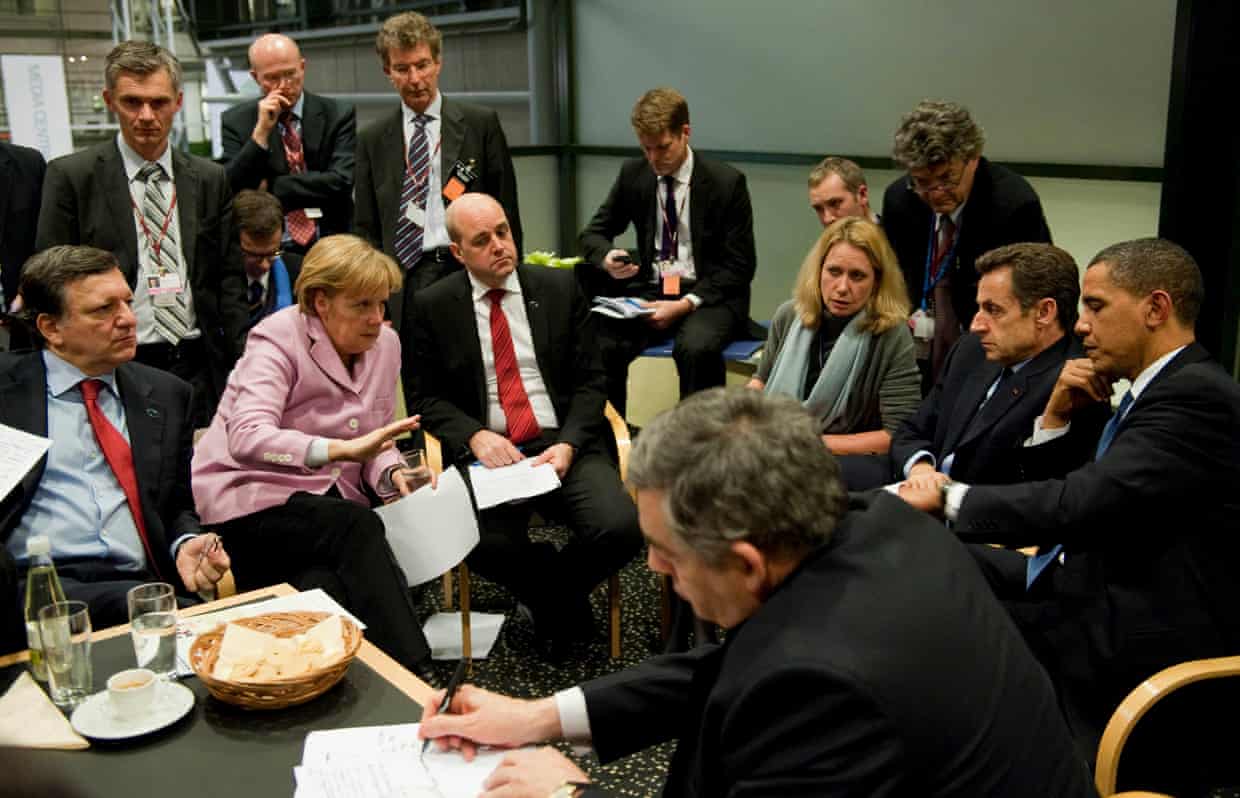
The then German chancellor Angela Merkel, centre, with the then European Commission president Jose Manuel Barroso, left, and other world leaders at the final night of Cop15 in December 2009 in Copenhagen. Photograph: Getty Images
In nearly every year since 1992 – bar a handful of hiccups from recessions and the pandemic – global greenhouse gas emissions have risen. Repeated scientific warnings have failed to stop us, and even the lockdowns – which cut carbon output by between a quarter and a third, when they bit hardest – made only a temporary dent, as emissions have rebounded faster than ever. We have not learned, it appears: the IEA forecasts that next year, emissions will jump by the second-highest amount on record.
António Guterres, the UN secretary general, warned after the IPCC report that we were approaching the brink.
This is a code red for humanity. The alarm bells are deafening, and the evidence is irrefutable: greenhouse gas emissions from fossil fuel burning and deforestation are choking our planet and putting billions of people at immediate risk.”
Hopes and setbacks over the years
The resolution at Paris to “pursue efforts” to limit heating to 1.5C very nearly didn’t happen. When world leaders met in Paris in 2015, the crowded halls were haunted by the ghosts of previous Cops, a long-running series of largely failed attempts to forge an effective climate treaty.
Under the UN Framework Convention on Climate Change, signed in 1992 on a rise in environmental optimism – the world had just, in the nick of time, rescued the ozone layer, and even rightwing leaders like the UK’s recently deposed Margaret Thatcher and then US president George Bush had been pressing for climate action – nations are bound to “prevent dangerous anthropogenic interference with Earth’s climate system”.
The treaty did not set out precisely what that meant, calling for greenhouse gas levels in the atmosphere to be stabilised but without specifying at what level, and it acknowledged that developed countries should bear the main responsibility while developing countries continued to prioritise economic expansion. So the “conferences of the parties” began, seeking a way to implement these aims.
For years, they failed. There were moments of hope, but each was followed by setback. The Kyoto protocol was signed in 1997, placing on developed countries specific national obligations to cut greenhouse gas emissions, adding up to a collective target of reducing carbon by about 5% by 2012.
But the US never ratified the protocol. The deal-breaker for the US Congress was that China and other emerging developing economies were exempt from cutting emissions. Rapidly growing China was coming to be seen as a rival, and US lawmakers – goaded by the powerful vested interests of the fossil fuel lobby – were persuaded that cutting emissions would be economically burdensome and result in jobs migrating overseas. (In the event, they migrated anyway, and emissions rose too.)
In Copenhagen in December 2009, the world tried again. There was an added sense of urgency: in 2007, in its fourth comprehensive assessment of climate science since 1990, the IPCC had found it was “unequivocal” that the climate was changing, with more than 90% certainty that this was the result of human actions. Scientists agreed that warming greater than 2C was likely to lead to uncontrollable impacts, that if restrictions were not imposed a rise of 6C was likely, and that time was fast running out to keep warming within any limits.
The signs were good for Cop15 in Copenhagen. Under a new Democratic president, Barack Obama, the US had re-engaged in international diplomacy and was poised to take action on its own emissions. “The US is back!” declared Todd Stern, climate envoy to Obama.
The Cop15 plan was to meet for two weeks to hammer out a “political declaration” on cutting emissions that would be signed by the world’s political leaders, scheduled to fly in for the closing days. But it quickly became apparent that there was a gulf too far to be bridged: small developing countries wanted to include a commitment to stay within 1.5C, but bigger developing countries such as China and India were reluctant.
Disagreements over the details were amplified by organisational disarray, and the conference ended in discord, chaotic scenes and recriminations. Copenhagen was derided as a failure, but this obscured an underlying achievement – for the first time, countries including the US and China had agreed a workable plan on emissions cuts, and developing countries agreed to curbs on the future growth of their emissions. Underneath the shouting and the blame-game, there was, as later recalled by Christiana Figueres, the UN climate chief who took over after the conference, “a very successful failure”.
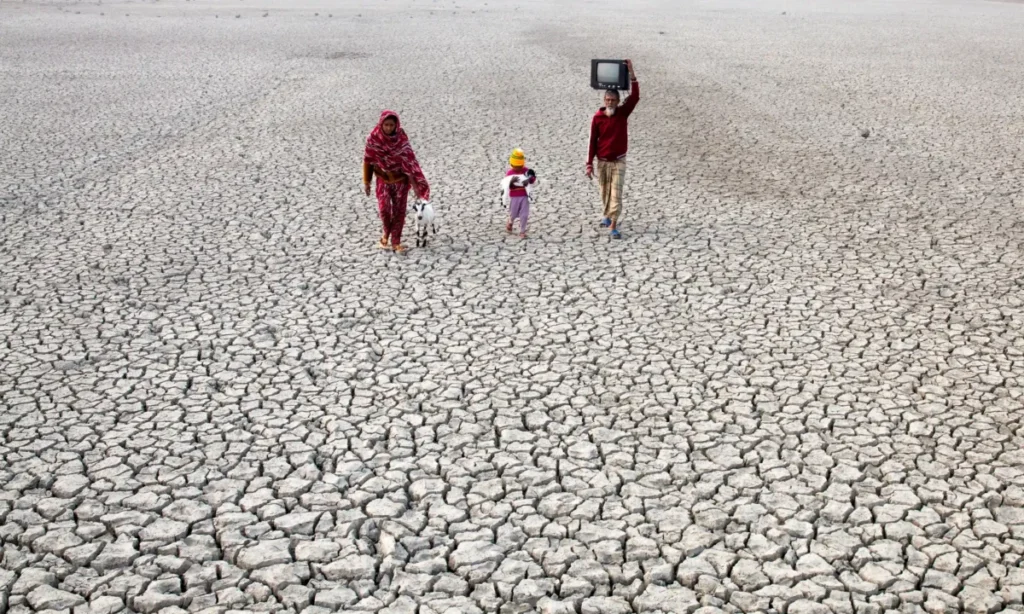
A woman watches wildfires tearing through a forest in the region of Chefchaouen in northern Morocco in August 2021. Photograph: Fadel Senna/AFP/Getty Images
Shifting alliances
For small developing countries, the lessons of Copenhagen were manifold but one stood out. The two-decade-old division of the world into developed and developing countries – set out in the UNFCCC treaty, codified further in the Kyoto protocol – disguised a newly evolving world order, in which the national interests of the economic powerhouses of the developing world were rapidly diverging from those of its poorer members.
For two decades, the interests of developing countries at the talks had been treated as identical. China negotiated alongside the G77 group of poor nations, and was looked to as their leader. Where many countries had relied on debt and loans from the US and the west, now they could look to burgeoning Chinese overseas investment, in roads, transport networks, mines, farms and natural resources.
Yet by the 2010s these countries were vastly different. China, India and a few other large developing economies had pulled away from the pack, industrialising at a faster pace than the world had ever seen. China overtook Japan to become the world’s second-biggest economy, after the US, in 2010. India’s fast-growing tech and service sectors fuelled a burgeoning middle class. These advances came at a carbon cost – industrial expansion ran on cheap domestically produced and imported coal.
Copenhagen showed the first fraying of developing country consensus, in the fights over whether 1.5C should be kept within sight. Two years later, the split was confirmed, at a climactic conference in 2011 in Durban, South Africa, that paved the way for the Paris agreement.
Negotiators in Durban were exhausted after Copenhagen, and few expected to make much progress. But the EU, sensing a closing window of opportunity, came with a plan. Connie Hedegaard, the EU commissioner, who as Danish environment minister had presided over Copenhagen and was unfairly blamed for much of the chaos, was determined to make progress. She demanded that countries sign up to a roadmap that would lead to a new treaty, requiring developed and developing countries to share obligations on cutting emissions – the format that became the Paris agreement.
At the talks, she took soundings from smaller developing countries. They were the ones with most at stake, but being lumped in with fast-growing economies like China and India, whose priority was growth at any cost, was not serving them well. Longstanding alliances began to shift, with the most vulnerable countries inclined to side with the EU in a 130-plus member “coalition of high ambition”.
The talks dragged on for a fortnight without resolution, and wearied countries proposed putting any resolution off for six months or another year. But Hedegaard was adamant: postponement could be fatal to her fragile coalition, a decision must be made. After a 50-plus-hour negotiating session, there were three parties left standing – the EU pushing for a roadmap, and China and India dramatically opposed.
Close to dawn on the final Sunday morning, China and India could see they were isolated and agreed to the timetable that four years later produced the Paris agreement. The seeds had also been sown for a new force at the UN talks: the “coalition of high ambition”, as one UK minister put it.
After Durban, it became clear that the balance of the UNFCCC talks had shifted. As nations gathered in Paris in 2015, the French were careful to keep a mention of 1.5C on the table, despite opposition from some countries. But there was a real danger of the commitment being watered down or left out altogether.
With just three days to go, the Marshall Islands negotiator Tony de Brum, uncle of current Marshall islands envoy Tina Stege, made his move. He had been quietly working with the EU, with scores of developing countries, with the US and others, persuading them of the moral necessity of keeping a 1.5C target. The High Ambition Coalition broke cover, declared as a formal grouping of more than 100 countries – even including the US, Canada and Australia (under a very different government from today’s climate-ambivalent Scott Morrison). They succeeded in keeping 1.5C in the Paris agreement.
Some countries were not pleased. China “hated the High Ambition Coalition”, said a developed-country diplomat. But the commitment now has legal force, and the twin goals of “well below” 2C and “pursuing efforts” to 1.5C point in a similar direction, according to Kerry. “It was not 2C, it was well below 2C, so what was settled on was not 1.9C or 1.8C or 1.7C but well below 2C, and 1.5C is not so far off that,” he says.
For the UK, the key to success at Glasgow and presenting a convincing case that 1.5C will be met will be holding together the coalition of developed and developing countries that carried the day in Durban and Paris. To get the consensus the UN process demands, the hosts will also need some countries that oppose climate action to stay quiet.
The key countries that are antagonistic are the fossil fuel producers – Russia, Saudi Arabia, Australia – and Brazil, which under Jair Bolsonaro is intensifying the destruction of the Amazon. At previous talks some of these countries have flung obstructions into the negotiations behind the scenes, held up progress on technical issues or held out on aspects of the agreement.

Steam and fumes billow from the brown coal-fired Niederaussem power plant near Bergheim, Germany. Photograph: Oliver Berg/EPA
Questions over UK presidency
The tortuous history of the climate negotiations and the efforts it took to get to this point clearly illustrate how pivotal the UK’s role is, as host and president of Cop26. That role began in September 2019, but was disrupted by the pandemic. Despite the wearying nature of zoom diplomacy – “breakfast in Seoul, Berlin for lunch and New York for dinner,” as one UK diplomat tells the Guardian – the talks have progressed virtually.
Even getting countries to agree that 1.5C should be the aim of Cop26 represents significant progress, given that many of the main players – China, India, Russia, Saudi Arabia – had balked at or questioned the 1.5C goal in the past. Kerry points to statements China made at a pre-Cop26 climate summit held by Joe Biden in April. “China came onboard with entirely new language – that the [crisis] is urgent and we have to take action in the 2020s and 2030s, that we need to cooperate with each other, we need to work to 1.5C and well below 2C. China embraced [1.5C] in that context,” he says.
The UK has arguably already succeeded in several of the aims of the conference. Staying within 1.5C will require annual greenhouse gas emissions to be stabilised at net zero by mid-century, according to scientific advice. The term “net zero” was scarcely used in Paris, and is found nowhere in the agreement, but means reducing greenhouse gas emissions as far as possible then offsetting any remaining irreducible emissions by fostering carbon sinks, such as forests.
Countries responsible for about two-thirds of global emissions have now declared national targets to reach net zero emissions around mid-century, including China, which has set the goal for 2060. That is a major step forward, given that two years ago only the UK and a handful of others had a net zero target in law.
Net zero, though, is not enough. The atmosphere responds to cumulative carbon, so unless emissions are brought down swiftly, we could reach net zero by 2050 but have emitted so much in the meantime that we burst through the 1.5C limit anyway.
Another win for the UK is on climate finance. At Copenhagen in 2009, developing countries were promised $100bn (about £73bn) a year would flow to them, from public and private sources, to help them cut greenhouse gas emissions and cope with the impacts of extreme weather. That promise has so far gone unmet: a recent OECD report found only about $80bn was provided in 2019. A report from the German and Canadian governments, commissioned by the UK, published just ahead of Cop found that the $100bn target would be met in 2023, on current pledges.
Sharma recognises that the NDCs are at the core of Cop26 and has spoken frequently of climate finance as “matter of trust – which is fragile”. But in the quest to keep 1.5C alive, the UK is also pursuing several side deals. These include an agreement to halt deforestation by 2030; deals to phase out the use of coal; moves to cut methane, a powerful greenhouse gas; potential measures on phasing out fossil fuel vehicles and cutting transport emissions; and commitments from banks to provide green finance and from leading businesses, sub-national governments, cities and other “non-state actors” to cut their carbon.
Of these, coal will be the hardest to achieve. Countries including China, Japan and South Korea have agreed to halt the financing of new coal-fired power plants overseas, which is a big step forward, but not enough. In response to rising energy prices, China recently announced plans to accelerate its programme of building new coal-fired power plants. India is also moving to increase its coal use.
Bernice Lee, the research director for futures at Chatham House, says: “It is not easy for China to move away from coal. A lot of the economy is dependent on it, and people outside China underestimate how deeply embedded it is in the Chinese system.”
The biggest question mark over the UK presidency is whether there is real engagement from the prime minister and the rest of the cabinet. Sharma has won plaudits from green campaigners and negotiators, world leaders and Cop veterans. But he has often seemed alone in the UK cabinet.
At the Conservative party conference, just a few weeks before the start of Cop26, the prime minister gave only a glancing reference to the summit, while the chancellor, Rishi Sunak, and the new foreign secretary, Liz Truss, managed not a word.
Contrast this with the French “360-degree diplomacy” ahead of Paris, when President François Hollande and his key cabinet ministers – including the foreign minister, Fabius; the environment minister, Ségolène Royal, ambassadors and a legion of officials – spent 18 months in a round of visits, conferences, speeches, public and private meetings.
The cabinet’s neglect of the issue even tipped over into farce: when Kerry chose London to make his biggest foreign policy intervention on the issue, a speech in Kew Gardens in June, not one member of the government came to greet him. Ed Miliband, the Labour shadow business secretary, and Sadiq Khan, the Labour mayor of London, received Kerry’s warm words from the podium instead.
It got worse. Boris Johnson, having said little on Cop26 all year, finally devoted his speech at the UN general assembly to the climate, but anyone expecting a reprise of Thatcher’s stirring call to climate action in 1989 was disappointed, as he veered off into quips about Kermit the frog. With three weeks to go before the UK’s chance to portray “Global Britain” as a climate saviour, he chose a holiday in Spain over the round of frantic last-minute diplomacy that the French employed before Paris.
Other moves by the UK government have also seemed designed to undermine Sharma’s mission rather than to help him. Proposals, green-lit by ministers, for a new coalmine in Cumbria attracted the anger of the former Nasa climate scientist James Hansen, provoking a storm before the issue was put out to public inquiry, and new oilfield licensing is going ahead, despite legal action and protests. The government’s lawyers argued climate commitments were “not relevant” to the decision, despite a report by the IEA, commissioned by the UK government, that showed all new fossil fuel development must cease this year, to stay within 1.5C.
Then there was the abandonment of the only “green recovery” measure, the green homes grant, after a few months of botched operation; the expansion of airports, and domestic flights, while raising train fares; supporting climate sceptic Mathias Cormann to be new head of the OECD; dropping a reference to the Paris temperature goals from a trade deal with Australia.
Most difficult of all, the government decided to slash overseas aid to developing countries from 0.7% to 0.5%, a bitter disappointment to poor nations as they struggled with the pandemic.
The government did manage to produce its net zero strategy just over a week before Cop26, setting out measures on heat pumps, nuclear, technology investment and tree-planting that it said would attract more than £60bn in private funding and generate 440,000 green jobs by 2030. Green experts worried that the £26bn from the government was insufficient, but it was clearly a relief to have a plan.
Overall, the impression given by the host nation in the last two years has been patchy at best, with Sharma the only consistent cabinet voice. If the UK succeeds in pulling off a deal at Cop26, much of the credit is likely to be due to Kerry, the EU and other key figures assisting the presidency behind the scenes.
The long road ahead

In the village of Hore Mondji, in southern Mauritania on the banks of the Senegal River, a women’s cooperative uses solar energy to operate the borehole that supplies water to the market garden. Photograph: Raphael Pouget/Climate Visuals Countdown
For Stege, going to Cop is a moral obligation, to warn the world and speak for those who are rarely heard. “The High Ambition Coalition is critical to this process. Sometimes, in the past year, when I have seen leaders of some of the biggest countries on national podiums talking about 1.5C – it still boggles my mind. We are so far now from where we were in 2009 and 2015. When 1.5C was inserted in the Paris agreement, at the push from the vulnerable countries, with the help of the High Ambition Coalition – it was politically significant at that time, it seemed radical at the time. But now it has become reality, based on the science.”
The countries on the frontlines of the climate crisis must be listened to, she said, because their reality today is what the rest of the world will experience tomorrow without swift action. “It has been a big arc to get to the 1.5C target. We have come a long way to get here, but we still have a much longer way now to go,” she says.

